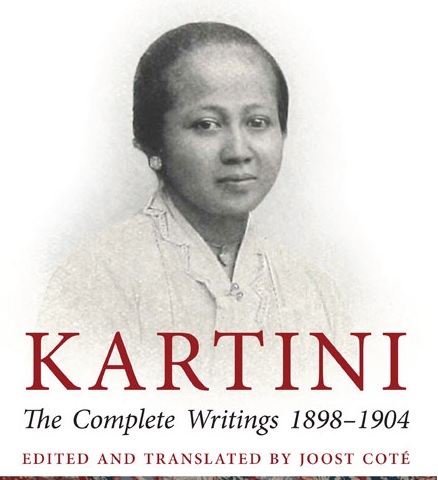Pam Allen
Reading Joost Cotè’s meticulously edited and finely translated anthology of Kartini’s complete writings, one is struck anew by the ironies in the life of this young woman whose symbolic status as pioneering nationalist and feminist is still largely unquestioned in Indonesia.
As a scholar of Indonesian literature, I was reminded of the fact that, not having written in Malay, Kartini is – formally at least – absent from the canon of early modern Indonesian literature. Ironically, only in translation is she accessible to modern Indonesian readers. I tend to concur with Cotè that there is a case to be made for including writing in Dutch by early Indonesian writers in the canon.
Another irony, as Cotè points out in his introduction, is that despite Kartini’s celebrity status both in Java and in Holland, her writing has never been collected in a single volume before. That is the mammoth task undertaken by Cotè in this book. Not only has he brought together the two previously published sources of Kartini’s correspondence, Door Duisternis tot Licht: Gedachten over en voor het Javaansche Volk and Kartini: Brieven, he has included all Kartini’s known published writing. In total, the book comprises 141 letters (some incomplete) to ten European recipients (some of whom Kartini never met), four short stories, two ethnographic articles, two memoranda to government officials, and three descriptive accounts. The volume begins with an historical introduction, which provides a succinct but useful contextual framework for the events and people referred to in Kartini’s writing, as do the shorter introductions to each chapter.
What, then, might a reader already familiar with Kartini’s letters gain from reading this anthology?
One thing that becomes apparent is that Kartini developed her feminist ideas, her views about education and her aspirations very much in collaboration with her two sisters, Roekmini and Kardinah, who continued to promote her vision after her untimely death in 1904. Kartini frequently wrote using one of two pseudonyms – Tiga Saudara (‘The Threesome Siblings’) or ‘Cloverleaf’, indicating that much of her writing was probably collaboratively produced. Even when she signed her letters ‘Kartini’, she often employed the pronoun ‘we’ in the body of the letter. In a letter to Stella Zeehandelaar in August 1900, Kartini declared unequivocally that ‘we three are one’.
We also gain an understanding of the depth of Kartini’s enthusiasm for Javanese arts and crafts, in particular batik, gamelan and woodcarving. One might observe the irony in the fact that Kartini’s admiration of modernity was matched by her concern to maintain and preserve these key elements of Javanese tradition. Cotè, however, points out that this reassertion of tradition might also be read as ‘evidence of emerging modern consciousness, a sense of Javanese cultural nationalism’. For, while her vison and her underlying nationalist sentiments may have helped set in motion – after her death – the early Indonesian nationalist movement, Kartini herself was through and through a Javanese. As Cotè observes, she articulates little sense of an ‘Indonesia’ beyond Java.
We also witness Kartini’s growing understanding of herself as a Muslim. Her early letters are either devoid of any reference to religion – perhaps because she saw religion as contributing to the oppression of women – or openly dismissive of Islam, as in her letter of 6 November 1899 to Stella Zeehandelaar, in which she writes, ‘I cannot tell you about Islamic teachings, Stella … to be honest, I am a Muslim only because my ancestors were. How can I love my teachings if I do not know them, may not know them?’ By 1904, however, while still critical of ritualistic, formalistic and intolerant Islam, she is comfortable about projecting herself as a Muslim, embracing a form of Islam influenced by the traditional Javanese belief system of kejawen.
Of course the ultimate irony of Kartini’s life, as has so often been observed, was her ‘apparent acquiescence to a polygamous marriage’. Reading her letters helps to contextualise this ‘acquiescence’ within her deep love for her father. There is a suggestion in some of her letters that she was periodically dogged by sadness, if not depression. This is poignantly summed up in her comment to Rosa Abendanon, ‘There were days, so pitiless and sad, that with my whole being I prayed for an end to my earthly existence and I would have ended it myself – if I had not so utterly loved … my Father’. Such declarations of her profound love for her father are common in her letters. ‘I could never be happy,’ she wrote to Stella, ‘even were I free, even if independent and emancipated, if thereby I would make Father wretched.’ So when her erstwhile enlightened father, Sosroningrat, expresses views such as the following (to Director of Native Education Jacques Abendanon), the extent of Kartini’s dilemma becomes obvious: ‘When you were here on [sic] January I had already told you that I had no objections to our two oldest daughters wanting to study in order to later be able to establish a school for daughters of Native officials but that, if they should meet someone worthy, then I would prefer that they married’.
As her detractors have observed, and as Cotè reminds us, ‘Kartini in fact “achieved" very little in her brief adult life’. What this volume does, however, is demonstrate how her writing, her public profile and her relentless agitation paved the way for the development, after her death, of the first nationalist organisation Budi Utomo, for a marked increase in the number of women in government schools, and for the establishment of schools by women. Her gedachten, ‘her thoughts about and for her people’ continue to resonate in modern Indonesia.
Pam Allen (Pam.Allen@utas.edu.au) teaches Asian studies at the University of Tasmania, Hobart.
